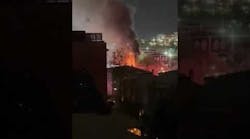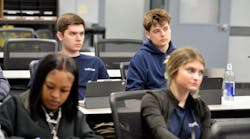December 23, 2009:
Today’s class started off – as a lot of our days do – with a motivational or philosophical session with Chief Morehead. His enduring theme is “customer service” and being a public servant first and foremost. It is a theme close to my heart as well, and he never disappoints me in bringing great examples, “war stories,” or personal insights on how to become a more customer service oriented public servant. Today he discussed the recent suspension of several east coast Emergency Medical Technicians who failed to go the aid of a woman experiencing a medical emergency. Chief Morehead focused on the acronym “SCHIPP:” Service, Courage, Honesty, Integrity, Pride, and Professionalism – these are the characteristics he is trying to build (or bring to full bloom) in the fire recruits.
Our written test (normally held on Friday), was moved up to today, and covered the topics of Firefighter Survival, Vehicle Extrication, and Terrorism. Following the exam, our instructor, Bernie Vrona, presented a lesson on Blood Borne pathogens. It is significant to note that the last Line of Duty firefighter death in Saint Paul (Firefighter Ray Hain) was attributed to a blood borne pathogen.
The afternoon sessions focused on firefighter survival and rescue skills. The practical exercises reinforced several recent classroom lectures on firefighter survival, Rapid Intervention Team work (rescuing firefighters), and rescue operations. There were 5 stations, and the class divided into small groups to go through each station. Radio communication between instructors and student groups kept us all informed of “when to rotate” to a new training station. The five stations were:
· Stair carries (how to move an unconscious civilian victim – or fellow firefighter – up and down stairwells)
· Wall breeches (how to make a hole in a wall and successfully move yourself or a victim through the space between the wall studs)
· Disentanglements (how to successfully avoid being entangled by downed wires inside a structure – and how to extricate yourself if you become entangled)
· Ladder bails (emergency egress from a burning building onto a ladder)
· The “Denver Drill” (recue of a downed firefighter through a high, narrow window)
The afternoon was A BLAST! It was tough, challenging, and made me THINK. The importance of THINKING, not panicking, and using good body mechanics were repeatedly driven home throughout the afternoon. I love physical and mental challenges, and today’s skill training added a third major incentive: saving my own life or the life of another firefighter/civilian. A “triple whammy” as far as I was concerned!
The stair carry station really stressed proper body mechanics for lifting another person. In our exercise, a team of two of us carried another fire recruit up and down the stairway inside the Drill Tower. Take a 180 pound firefighter, add 50 pounds of equipment, and add another 25 for good measure to simulate the weight of the gear when it’s wet. So 2 of us were carrying over 250 pounds of “dead weight” up 5 flights of stairs! We did it without undue strain and no injuries, thanks to proper positioning, good body mechanics, and liberal use of a “Morehead Strap” – a long loop of nylon webbing we carry in our the pockets of our turn out gear (many fire departments have these straps, known by various names). The strap extends your reach and provides a handhold for lifting in a wide variety of situations. The key to body mechanics is to keep your back straight, lift with the big muscles in your legs, and coordinate your movements with those of your partner. Real success on the stairway came when one firefighter lifted from the top/back of the victim (using the Morehead Strap), and the other firefighter PUSHED from the bottom (put the victims legs over your shoulders, use your arms to lift them up to the next step, and use your legs to support and drive the victim’s weight). Looks funnier than heck, I’m sure, but it certainly moves the victim up the stairs in a safe, efficient manner!
The Wall Breech Station was essentially a portion of a typical stud wall found in the interior rooms of most homes: drywall over wooden 2” x 4” stud walls. The studs are 14 ½ inches apart. Now, take a 200 pound firefighter, full turn out gear and SCBA tank, and make him get through a 14 ½ inch wide opening (without using an axe to make the opening bigger!). This skill reinforces the critical mental thinking necessary for making an emergency rescue when there is no other way out to safety – we might have to punch a hole through a wall and extricate ourselves from danger (or access a victim, or rescue a downed firefighter).
So how do you get through a 14.5 inch wide space while dressed in full turn out gear and SCBA? Crawl to the hole and turn so your back is facing the hole. Stick your air tank through the hole. Sweep your arm over your head like you’re doing the backstroke. Wiggle your shoulder through the opening as you turn on your side. Wiggle through the hole. You CAN do it!
The Entanglement Station was another simple, yet effective prop, provided by Hennepin Technical College. The prop can be easily constructed by firefighters wishing to practice this skill on their own or in a fire station. The prop is essentially a wooden box you crawl through, with a mess of wires and cords hanging down from the top of the box. As you crawl through the box in full gear, the wires, cords, and ropes get caught on your helmet, air pack, face piece, and a variety of other places on your body and entangle you. In a fire, suspended ceiling wire, electrical cords, drapery/window blind cords, and other hanging hazards can trap you. As you struggle to free yourself (or await rescue by fellow firefighters) your air can run out and you can get die. This skill station taught us some technique to avoid entanglement and how to extricate yourself if you are caught.
Some of the practical tips I learned were: the space beneath you is likely “clear” of any wires/cords (since they are hanging down or have fallen down on you) – keep that area clear. Use your arms to “swim” through the wires/cords and LIFT the wires up from the clear space underneath you. Start above your head (in front of you when you’re crawling) and sweep/lift the wires over your body – lift them up to create a clear spot to crawl into, and inch your way forward. If you get caught, feel your way to the cord or wire and attempt to free yourself – or cut your way out if you have a wire cutter in your pocket. All of these actions are taken, of course, AFTER you have radioed a “Mayday” call and told others that you are trapped and attempting to free yourself.
The Ladder Bail station was designed to teach us the basics of “bailing out a window” onto a ladder in extreme emergencies. Using a ladder raised to the second story window of our drill tower, we took turns bailing out of the window and sliding safely to the ground. The technique consists of the following essential steps:
Lean FAR out the window, bending head first and reaching as far down the ladder as you can.....hook your left elbow around a rung of the ladder.....reach down with the right hand to the next rung down the ladder....slide head first out the window and – using the elbow you have hooked around the rung as a pivot – swing your legs to the side and down the ladder...position your feet and hands on the outside beams of the ladder....slide feet first down to the ground. The elbow lock is made only with the elbow hooked around the rung – if you grab onto a rung with that hand, you’ll break your wrist. Even that would seem a small trade off compared to burning up inside the building, but all of us completed the drill several times (I did it four times), without injuries. It was a bit scary at first – essentially a leap of faith head first out the window – but after several successful practices, it turned out to actually be a very enjoyable, yet deadly serious, practical session.
The Denver Drill was so named because of a Denver firefighter, Mark Langvardt, who died in the line of duty in 1992. Trapped on the second floor of a commercial structure fire, he collapsed inside a narrow 28” wide storage room with a single window leading to the outside. The window sill was 42” above the floor. In spite of repeated efforts to rescue him, no one could maneuver inside the room, straddle him, and bodily lift him 42” straight up to get him out the window. He was 6’ 1” tall, weighed about 275 pounds with all his gear and equipment on, and was just too heavy and in too tight of a space for a successful rescue. Following his death, the Denver Fire Department recreated the room and tried dozens of ways to try to make a successful rescue. They figured it out eventually, and the “Denver Drill” is a well known exercise for teaching firefighter rescue from a narrow, confined space.
Our class practiced the Denver Drill with one person on the ladder outside the window and either one or two of my classmates and me in the room with the fallen firefighter. The secret was to pull the fallen firefighter away from the wall beneath the window, slide one rescuer in between the fallen firefighter and the wall, and use that firefighter as a human “ramp,” pushing the fallen firefighter up the ramp to the window. Body mechanics – getting the legs onto your shoulder and PUSHING with your legs (just like the stairway rescue) was the key to having enough strength to making the rescue.
The 5 practical stations today were mentally challenging, physically demanding, and they provided practical solutions to “real world” rescue situations. The skills taught us to THINK, to use good body mechanics and the big muscles in our legs for doing the heavy work, and gave us confidence in each other, our gear, and our own abilities. It was the best, most enjoyable day at the academy so far!
Today provided tremendous reinforcement to my ever expanding appreciation for firefighters and the services they provide! I am so impressed with the resourcefulness, the physical toughness, and the practicality of firefighters. Finding rapid, practical solutions to time critical and life threatening situations, and MAKING them work in spite of significant challenges is extremely important and rewarding work!! The physical and mental agility, the ingenuity, and the diligence in carrying out an action plan to assist others are some of the most endearing – and enduring - characteristics of the American Fire Service – and the American Firefighter! I am very honored to be serving alongside men and women of this high caliber!
Tim





